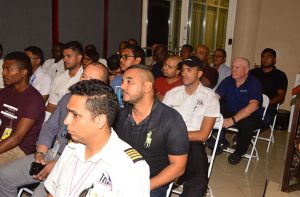– aircraft to be tracked, defaulters to face stiff penalties
GUYANA Civil Aviation Authority (GCAA) has implemented a series of stringent measures to monitor aircraft and operators within the Aviation Industry that would allow for the reporting of malpractice and tracking of aircraft.
With effect from Tuesday March 5, 2019, GCAA has initiated a ‘See Something, Say Something, Step Up, Save A Life’ initiative, an Automatic Dependent Surveillance Broadcast (ADS-B) System and a Mentorship Programme in direct response to the recent accidents, one of which resulted in the death of Captain Randy Liverpool.
Director General of Guyana Civil Aviation Authority (GCAA), Lt. Col. (Ret’d) Egbert Field, made the announcements on Tuesday, during a press conference at GCAA’s Headquarters at High Street, Georgetown – one day after he met with pilots and operators within the Aviation Industry, in light of the recent turn of events.
Field said the ‘See Something, Say Something, Step Up, Save a Life’ initiative forms part of the Aviation Authority’s Oversight Programme that would allow for the monitoring of operators, with the help of the citizenry, due to GCAA’s limited human resource capability.
“Under this programme the authority will establish a hotline for receiving anonymous calls, and receiving reports of violation of our airspace….The public will be asked to report on any untoward movement or any activity which does not confirm to regular practice of operation of aircraft either by operators or by pilots,” the Director General explained. The hotline number is 608 -4222.
According to him, all reports will be investigated and once an operator or pilot is found culpable of violating the safety of the country’s airspace or the handling of any aviation machinery contrary to the regulations, stiff penalties will follow.
“I will use the powers bestowed upon me in the law including our recently reapproved Civil Aviation Act to apply sanctions. The sanctions will include but not limited to revocation of license or air operators’ certificates,” Field explained.

He noted that the ‘See Something, Say Something’ initiative has been implemented in other parts of the world to assist with the monitoring of the Aviation Industry.
In addition to that, with effect from July, 2019, GCAA will fully implement the Automatic Dependent Surveillance –Broadcast (ADS-B) system, however, until then, it will be used for testing purposes.
ADS–B is a surveillance technology that allows for periodic broadcasting of an aircraft’s position via satellite navigation, enabling it to be tracked. GCAA has installed the ADS-B systems at the air traffic control towers at Kaieteur, Annai, Kamarang and Port Kaituma, complementing the primary air traffic control station at Timehri.
Field explained that the aircraft’s signals will be transmitted to the towers once they have transponders installed on them. “Our air traffic controllers will be able to track the aircraft for at least 75 to 80 per cent of Guyana from ground level to 60,000 ft, thus noting any aircraft deviating from its standard route or indulging in anything contrary to the regulation of our airspace,” he explained. At the moment, approximately 65 per cent of the aircrafts operating in Guyana have transponders installed. GCAA is in discussion with the operators of the remaining aircrafts to have all aircrafts equipped with ADS-B systems by July, 2019 when the system will be fully implemented.
The Director General said though the ADS-B system was being tested, nothing stops GCAA from using it. On Thursday, GCAA Director General will be meeting with his air traffic controllers to bring them up to speed on the ADS-B system. During that meeting, Field is expected to underscore the importance of proper tracking of aircraft.
The third initiative is the establishment of a Mentorship Programme which will be rolled out by the operators with support from GCAA. Field said the operators have been asked to submit a proposal for the mentorship programme for approval by March 31, 2019.
“Under this programme, seasoned and experienced pilots [with flying experience] beyond 10,000 hours will act as mentors for the junior pilots. At present in the industry, there are junior pilots, some of them very, very professional in their outlook and we aim to harness that professionalism, while there are a few who lack that professionalism [and need] guidance,” the Director General explained.
The Civil Aviation Authority has also taken further steps to increase ramp and aircraft inspections. Since 2015, GCAA has been increasing the number of ramp inspections conducted. Ramp inspection is an assessment of an aircraft on Guyana’s territory. In 2018, 205 ramp inspections were done when compared to nine (9) in 2015.
“The GCAA remains committed towards creating a safe, secure and modern civil aviation sector,” Field assured the reporters.
He said that investigations into the two recent accidents were ongoing. The first plane crash involving a Guyana Adventist Medical Aviation Services (GAMAS) Cessna 182 occurred on February 18, 2019, resulting in the pilot and a passenger suffering injuries. The second accident, which claimed the life of a pilot, involved a Cessna 206. The plane crashed at Eteringbang near the Venezuelan border on February 21, 2019.
The accidents are being investigated by Ms Paula McAdam, the designated Accident Investigator in Charge. McAdam, according to Field, will report directly to the Minister within the Ministry of Public Infrastructure with responsibility for the Aviation Sector, Annette Ferguson. He said that such was being done to allow for the independence and integrity of the investigations.



.jpg)








